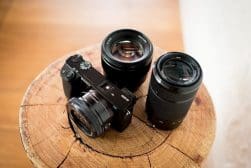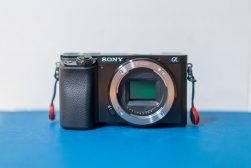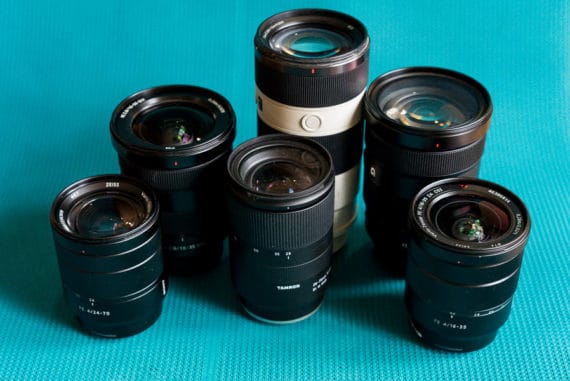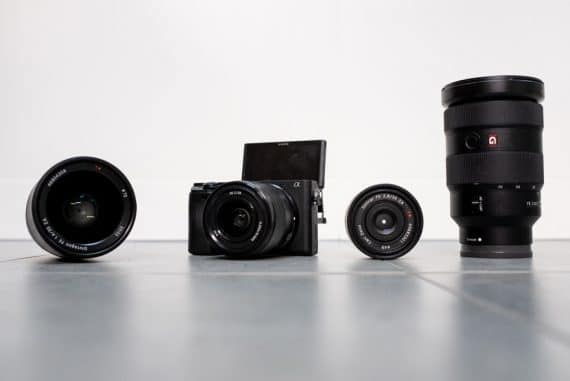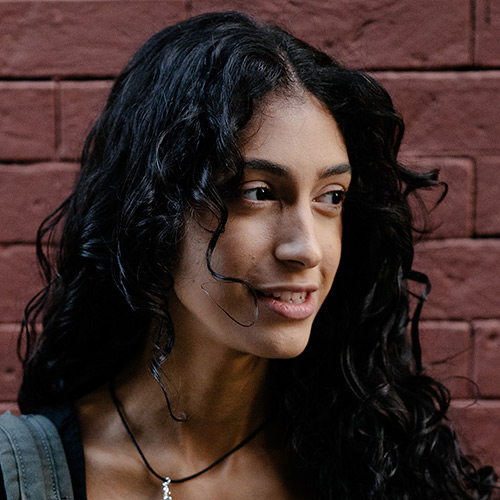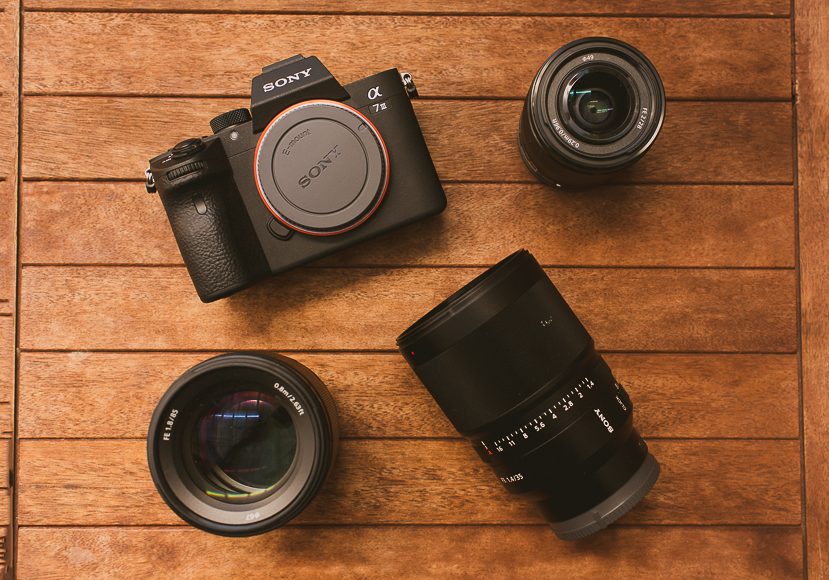
Best Sony Lenses in 2024: Ultimate E-Mount Guide
Which lenses are our top pick of the year so far? Discover what FE & APS-C lenses to use on your Sony Alpha mirrorless camera.
Camera Gear Guides | Lens Guides | Sony Lens Guides | By Mark Condon and Usnea Lebendig | Last Updated: February 14, 2024
To find the best Sony lenses, we based this guide on our research and combined 14+ years of shooting with Sony Alpha mirrorless cameras.
For professionals or those who need the best performance, Sony’s flagship G-Master lenses are still unbeatable, but there are also plenty of third-party lenses for Sony cameras that offer amazing bang for your buck.
Sigma lenses for Sony e-mount (APS-C and full frame) are popular, as are Tamron e-mount lenses and Samyang too – I use several of them in favour of Sony FE lenses on my full frame Alpha cameras.
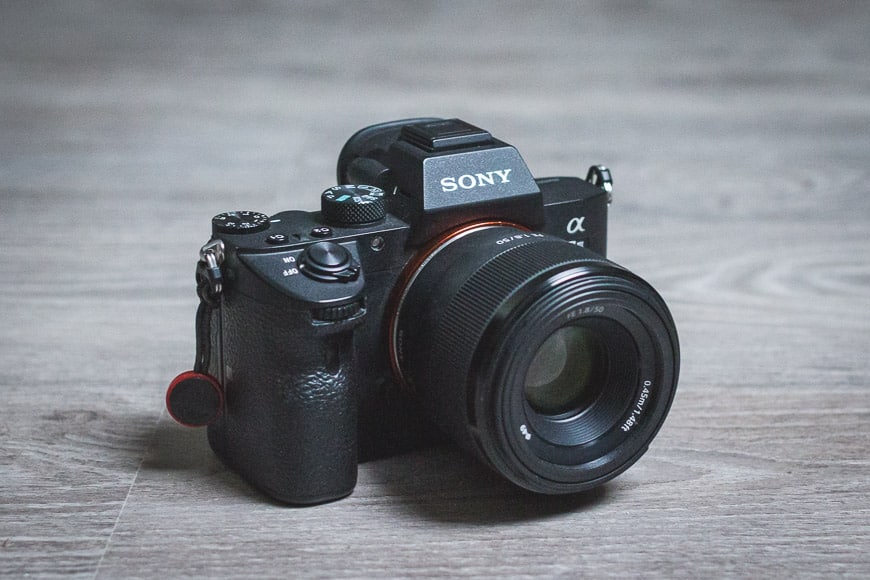
The best Sony lens for everyday photography on a budget. Great image quality and classic focal length (Also great as an 85mm lens on APS-C).
As for crop sensor APS-C Sony e-mount lenses, I’ve tested the latest options with a range of a6000-series compacts, sharing my top choices below.
Aside from stills photography, more and more video shooters are choosing Sony cameras, so we’ve got some recommendations on the best Sony lens for video work too.
Sony mirrorless lenses and the differences between the FE and regular e-mount can be confusing. Did you know you can even attach a Sony lens to a Nikon or Canon camera?
Don’t worry, though – we’ll explain all the options and answer all the most common questions in this guide.
First, though, let’s find out which Sony e-mount lens you should buy for your new Alpha camera.
What are the Best Sony Lenses in 2024?
| Image | Product | Features | ||
|---|---|---|---|---|
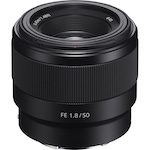 | Sony 50mm f/1.8BEST EVERYDAY PRIME |
| CHECK AMAZON PRICE →CHECK B&H PRICE → | |
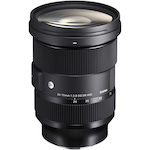 | Sigma 24-70mm f/2.8BEST ALL ROUND ZOOM |
| CHECK AMAZON PRICE →CHECK B&H PRICE → | |
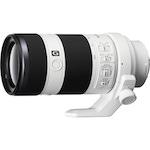 | Sony 70-200mm f/4BEST VALUE TELEPHOTO |
| CHECK AMAZON PRICE →CHECK MOMENT PRICE → | |
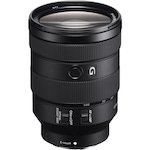 | Sony 24-105mm f/4BEST FOR TRAVEL |
| CHECK AMAZON PRICE →CHECK MOMENT PRICE → | |
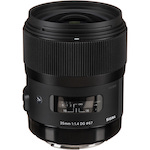 | Sigma 35mm f/1.4BEST VALUE 35MM |
| CHECK AMAZON PRICE →CHECK B&H PRICE → | |
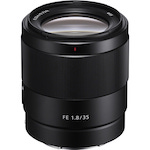 | Sony 35mm f/1.8BEST EVERYDAY PRIME (APS-C) |
| CHECK AMAZON PRICE →CHECK MOMENT PRICE → | |
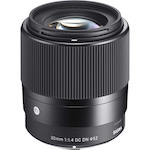 | Sigma 30mm f/1.4BEST FOR BLURRING BACKGROUND (APS-C) |
| CHECK AMAZON PRICE →CHECK B&H PRICE → | |
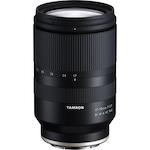 | Tamron 17-70mm f/2.8BEST ALL ROUND ZOOM (APS-C) |
| CHECK AMAZON PRICE →CHECK B&H PRICE → | |
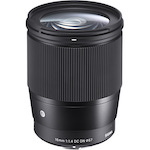 | Sigma 16mm f/1.4BEST WIDE ANGLE PRIME (APS-C) |
| CHECK AMAZON PRICE →CHECK B&H PRICE → | |
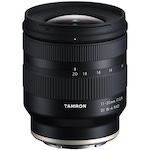 | Tamron 11-20mm f/2.8BEST WIDE ANGLE ZOOM (APS-C) |
| CHECK AMAZON PRICE →CHECK B&H PRICE → |

Why Trust Us?
Our experience with lenses for Sony Alpha cameras and how we tested
Your author Mark has been shooting weddings professionally with Sony cameras for several years, using many different Sony prime and zoom lenses, as well as 3rd party e-mount options.
Co-author Usnea has been using Sony cameras for six years, shooting landscape, nature, action, and travel photography using primarily native Sony lenses.
For testing, Mark used the latest Sony a7IV full-frame mirrorless camera to evaluate a selection of Sony FE-mount lenses and a Sony a6100 for lenses designed for the APS-C format.
The recommended lenses in this guide were chosen based on Mark & Usnea's own personal experience, results of lens reviews by our various Shotkit authors (also professional photographers), and over 120 hours of combined research and analysis.
We are not sponsored by any of the brands that appear here, and our opinions are completely unbiased - in short, you can trust what we say!
What are the best Sony e-mount lenses for a1, a7 & a9 Series Full Frame cameras?
If you’re reading this first section of our guide, you’re either a professional photographer or someone who understands why investing in the best lenses will get the most out of a full-frame Alpha camera.
All the lenses below work on the a1, a7, and a9 series of Sony mirrorless cameras – they also work fine on Sony APS-C cameras, should you own one of those too.
(See further down our guide to see the Sony e mount lenses recommended for APS-C ‘crop-sensor’ Sony cameras.)
Let’s take a look at the top recommendations so you can choose the best Sony lens for your full-frame Sony Alpha camera.
1. Sony FE 50mm f/1.8 | Budget Starter Sony e Mount Lens

Credit: Andy Day
- Fast f/1.8 aperture
- Beautiful images
- Fantastic value
- Lightweight
- Autofocus could be better
- Feels cheap (because it is!)
When I was just getting my Sony a7III, I opted out of the kit lenses and just shot with this nifty-fifty until I could afford some premium Sony Alpha lenses. I wasn’t expecting much from a $250 lens, but boy, was I wrong!
For the price, the image quality of this Sony e lens is amazing. Photos come out startlingly sharp, nicely contrasty, and with great color. The bokeh is nice and creamy, and there’s nothing distracting in the out-of-focus areas.

Sony A7 III + Sony FE 50mm f/1.8 | 1/250 f/1.8 ISO 125 | Andy Day
The only real downside of this lens is its autofocus. It definitely hunts a bit if you’re too close to your subject or in super low light. It’s also not the quietest. Still, it functions great most of the time.
Otherwise, this is an excellent 50mm at an absolutely fantastic price. It’s the first of all the Sony lenses we recommend for Sony e-mount full-frame mirrorless cameras if you’re on a tight budget.
2. Tamron FE 28-75mm f/2.8 Di III VXD G2 | Best Value Zoom
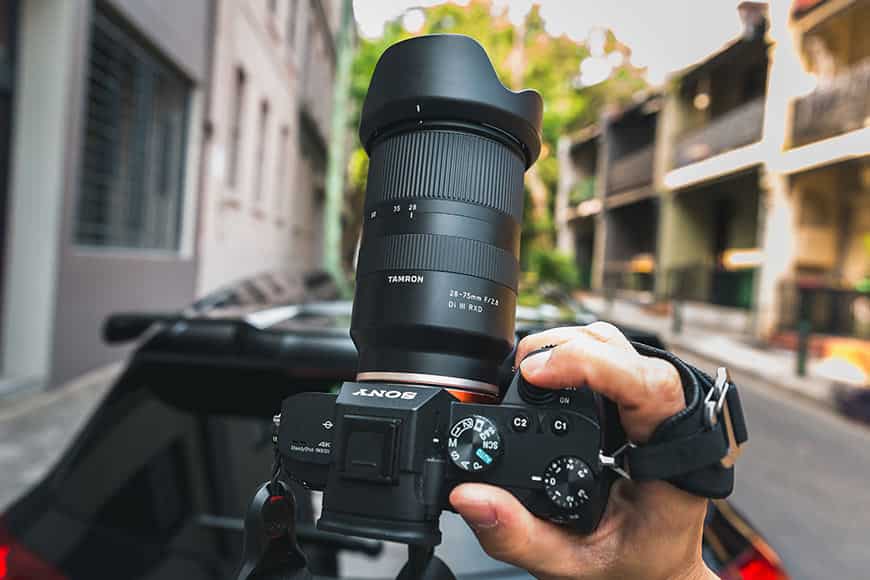
Credit: Tommy Williams
- Constant f/2.8 aperture
- Much lighter and more compact than its rivals
- Fantastic optics
- Professional-level sharpness
- Good build quality
- Weather-sealing
- Excellent close-focus distance
- USB port for firmware updates
- No optical stabilization
- Vignetting & Distortion heavily corrected (hidden)
- No external AF/MF switch
A good mid-range zoom is a must for almost every kit, but finding one of the best lenses for less than $1000 isn’t so easy….that is, until Tamron came out with the 28-75mm f/2.8 Di III VXD G2.
Light, compact, and available for under $700, it’d be easy to assume that this e mount zoom lens was just a mediocre lens. In reality, however, the Tamron 28-75mm f/2.8 can more than pull its weight in both image quality and performance.
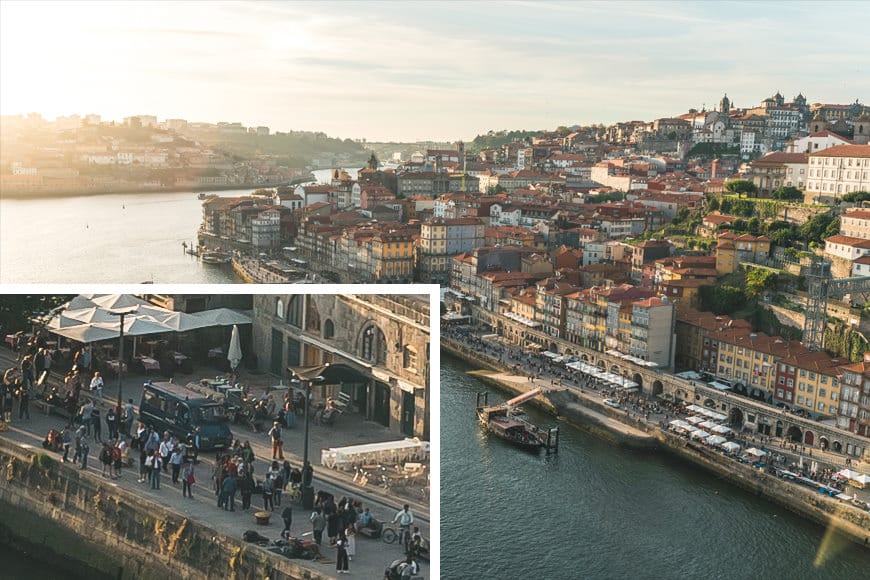
Sony A7 iii + Tamron 28-75mm f/2.8 @ 34mm | 1/640 | f/6.3 | ISO 100 | Tommy Williams
On top of that, it’s much lighter and literally costs less than half as much as the Sony 24-70mm f/2.8 GM. (The Sony 24-70 f/2,8 weighs nearly a full kilogram!) This is arguably one of the best lenses for Sony e mount in terms of portability.
The only real reason not to buy this lens is if you really need that extra 2mm on the wide end.
Otherwise, this lens is an incredible value and should be at the top of the list of e mount zoom lenses for any full-frame Sony shooter looking for an exceptional mid-range zoom. Personally, I like to use it for travel, wedding and car photography.
3. Sigma FE 24-70mm f/2.8 DG DN Art | Best All Round Fast Zoom
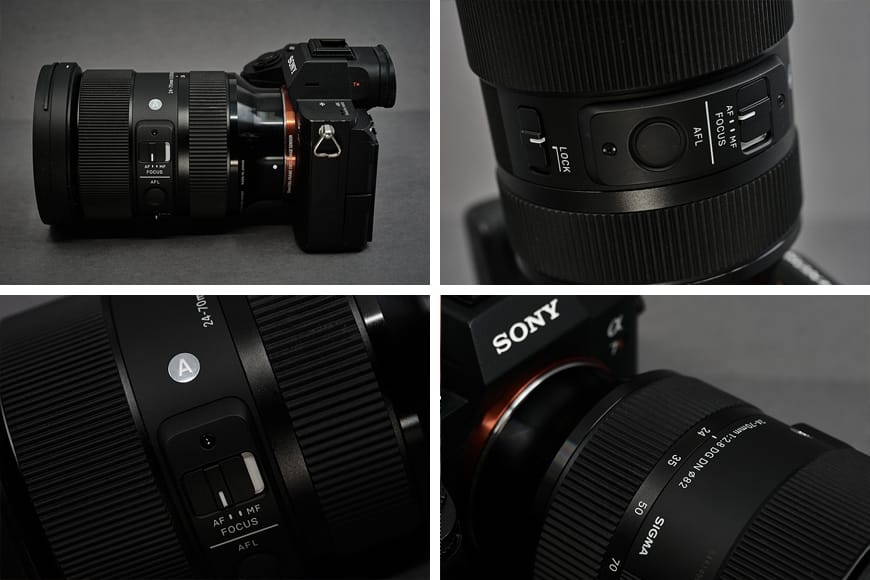
Credit: Athol Hill
- Professional-quality optics
- Outstanding color rendition
- Extremely sharp
- Fast, accurate, and completely silent autofocus
- Image stabilization
- Great macro abilities
- Beautiful bokeh
- Well-built
- Weather sealed
- MF/AF switch and autofocus lock button
- Fantastic value
- Less than stellar flare resistance
- 82mm thread makes filters expensive
If the Tamron 28-75mm f/2.8 isn’t wide enough for you, your next best bet in the mid-range zoom category is the Sigma 24-70mm f/2.8 DG DN Art lens. Also another great Sony e mount zoom lens.
The most popular focal range in all of photography, the 24-70mm zoom is one of the most versatile in the industry. The wider end (24mm) is suitable for both landscapes and interiors. The longer end (70mm) allows for nice portraiture.
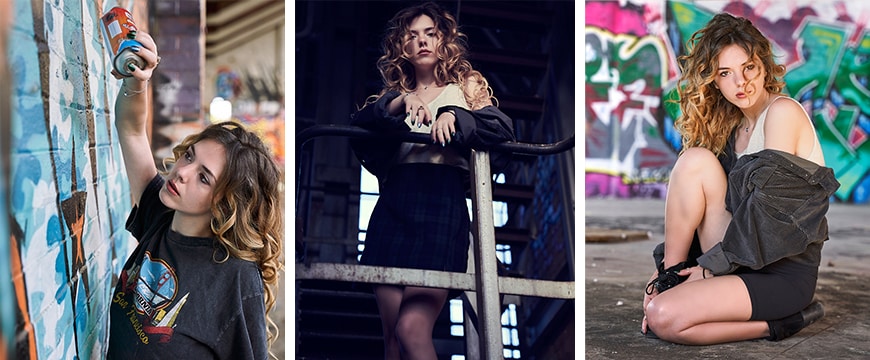
Sony A7Riii + Sigma 24-70mm f/2.8 DG DN ART | Athol Hill
But there are many more reasons to buy this lens: the autofocus performs perfectly, the optics are fantastic, it has a bright, constant f/2.8 aperture, and it comes weather-sealed.
It’s also an incredible value, coming in at just over half the price of the Sony FE 24-70mm f/2.8 G Master, all without sacrificing image quality or performance. (It’s also a tad smaller and lighter.)
Definitely worth a look if you’re in the market for a great 24-70mm f/2.8 zoom.
4. Sony FE 24-105mm f/4 G OSS | Best Sony G Lens for Travel, Most Versatile
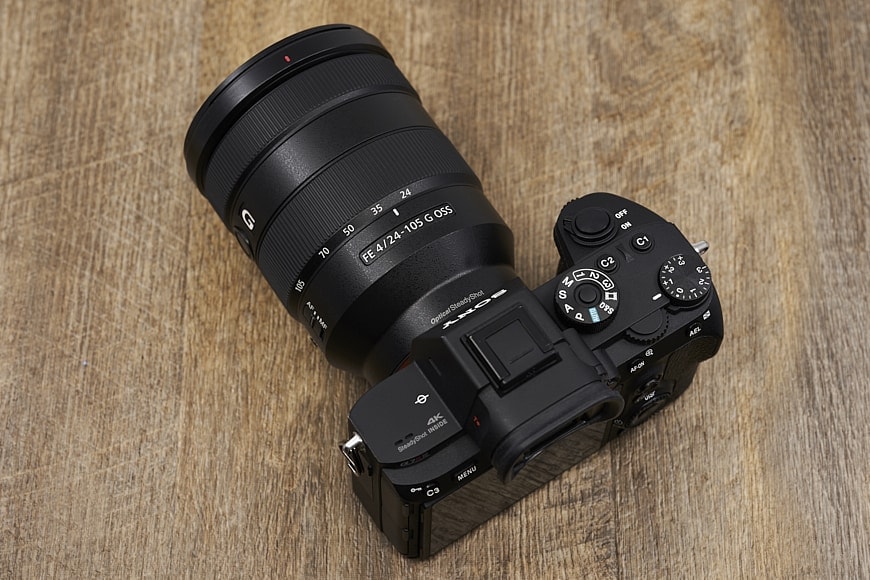
Credit: Athol Hill
- Nice color rendition
- Good flare resistance
- Quick, quiet, and accurate focus
- Excellent build
- Image stabilization
- AF/MF and SteadyShot switches
- Weather sealed
- Expensive
- No smaller than comparative DSLR lenses
- No zoom lock switch
Looking for a lens that can do it all? Take a look at the Sony FE 24-105mm f/4 G OSS. One of the versatile Sony lenses e mount compatible.
The Sony OSS lenses offer Optical SteadyShot, a gimbal mechanism that stabilizes lenses more effectively than other optical systems.
It’s wide enough for landscapes, cityscapes, and architecture while covering a fair bit of the near-telephoto range as well. That’s what makes it a great travel lens: it will handle just about any shooting situation you might find yourself in.

Sony A7Riii + Sony 24-105mm | Athol Hill
A pro-level lens with excellent optical performance throughout its entire focal range, the Sony FE 24-105mm is also the lightest lens in its class, which makes it an excellent zoom for carrying around.
If you need something less expensive and can handle the added weight, the Sigma 24-105 ART costs considerably less and performs almost as well.
If, however, you want native glass at this focal range (and can fork out the extra dough), this is the one to get for a one-in-all travel lens.
5. Sony FE 70-200mm f/4 G OSS | Best Sony Telephoto Lens
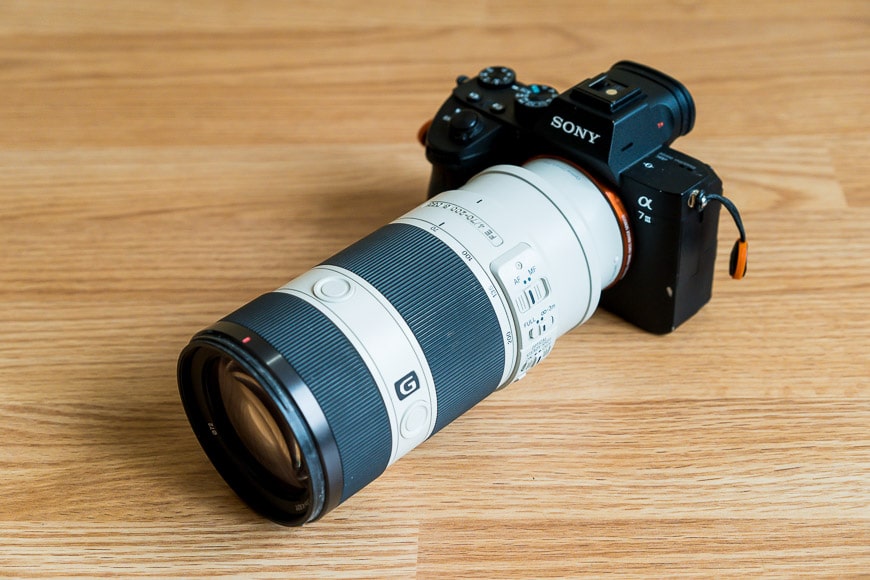
Credit: Marc Bergreen
- Fantastic image quality
- Useful focal range
- Durable and rugged
- AF/MF switch
- Tripod collar included
- Great price point
- Some corner softness
Of all the telephoto lenses offered in the Sony Alpha lens lineup, the Sony FE 70-200mm f/4 G OSS is by far our favorite mid-range telephoto lens.
The focal range is useful for everything from sports and wildlife to studio photography. It’s also a fantastic portrait photography lens, as the classic 85-135mm portrait sweet spot is nestled right in the middle.
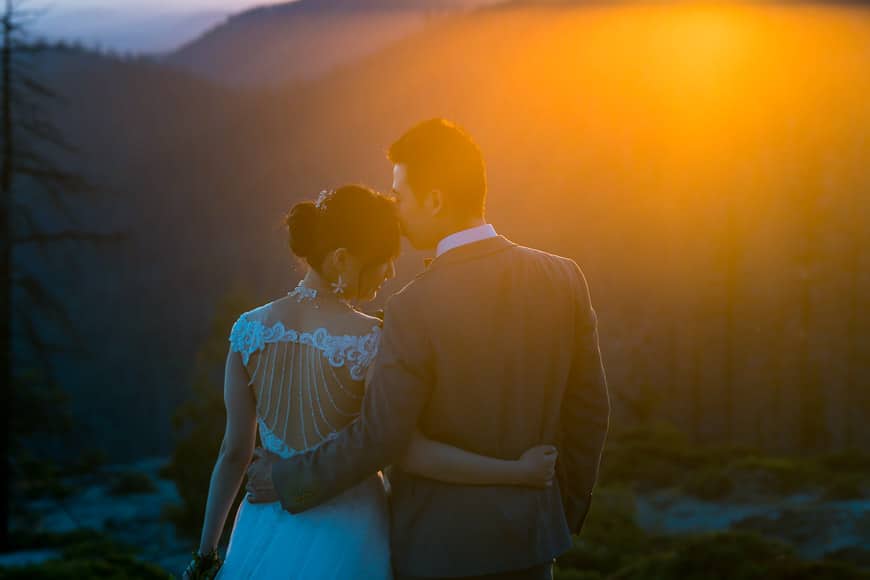
Sony A7III + Sony 70-200mm f/4 | 1/125 f/6.3 ISO 640 | Marc Bergreen
The constant f/4 aperture isn’t the fastest, but it makes the Sony FE 70-200mm f/4 G considerably smaller and lighter than its much more expensive cousin, the f/2.8 GM.
With a small(er) footprint combined with a fantastic price point (under $1500), the only reason to bump up to the f/2.8 GM is if you really need that extra stop of light. (Just keep in mind, you’ll be paying an extra $1400 for it!)
6. Sony FE 85mm f/1.8 | Best Value Portrait Prime
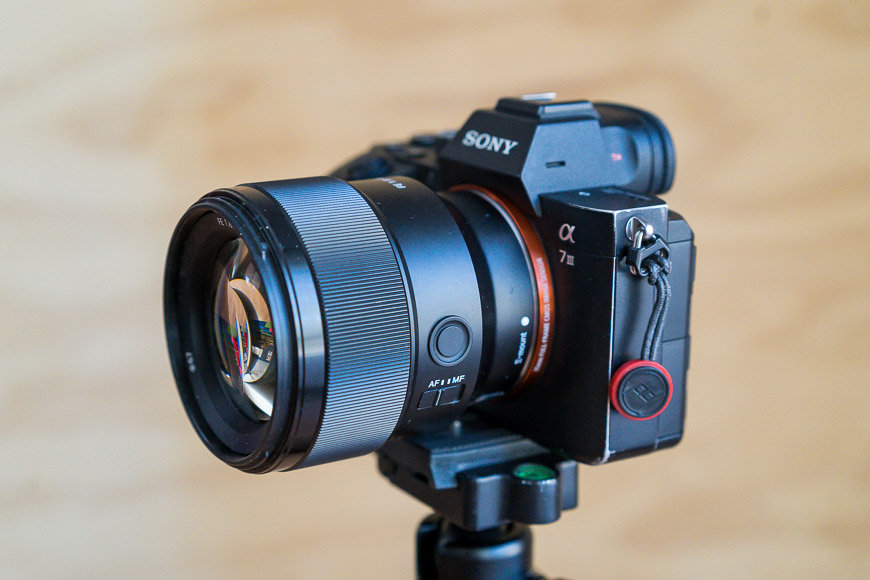
Credit: Marc Bergreen
- Fantastic autofocus
- Strong optics
- Compact and lightweight
- Nicely built
- AF/MF switch and AF Hold button
- Excellent price-to-performance ratio
- Weather-sealed
- Bokeh not as smooth as it could be
- Strong vignette at wider f-stops
If you’re looking for a good portrait photography prime lens but find yourself on a tight budget, the Sony FE 85mm f/1.8 might just be the lens for you.
Images come out crisp and clear, the autofocus works like a charm, the aperture is fast enough for most applications, and the size and weight sit nicely on all Sony full-frame cameras.

Sony A7III + Sony 85mm f/1.8 | 1/5000 f/2 ISO 100 | Marc Bergreen
Of course, there are plenty of other options out there, but none with so much bang for the buck.
At under $600, the Sony FE 85mm f/1.8 beats out the Zeiss Batis 85mm F1.8 by more than $600 and the G Master f/1.4 by a full $1200! (Sony G Master lenses also happen to be much heavier.)
7. Sigma FE 35mm f/1.4 DG HSM | Best All Round 35mm
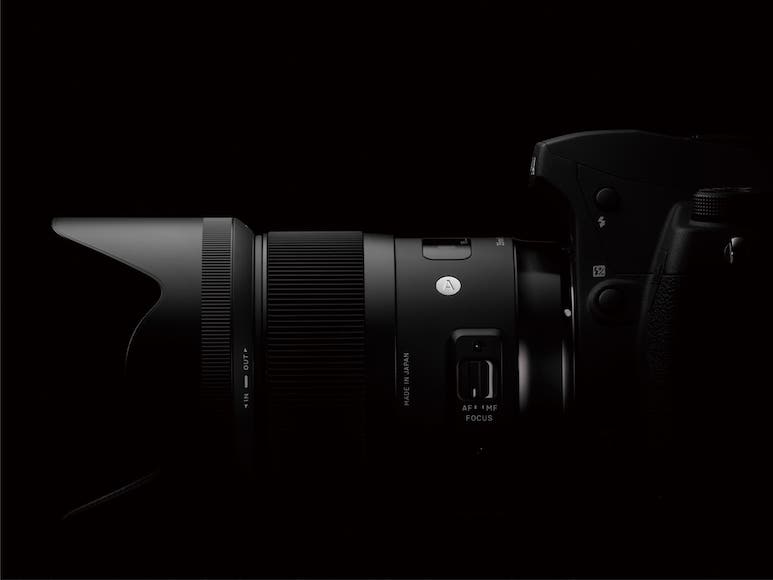
Credit: Sigma
- Fast and quiet autofocus
- Fantastic sharpness
- Superb color rendition
- Immaculate build quality
- Nice bokeh
- Weather-sealing
- Larger and heavier than the GM lens
Small on price, yet big on both design and performance, the Sigma 35mm f/1.4 DG HSM is easily the best 35mm for Sony A7 cameras in terms of performance plus value.
The build on this beauty comes with all the features you’d expect from a much more expensive lens: weather sealing, a focus hold button, and aperture control.
The autofocus is fast, quiet, and precise. Images come out fantastically sharp, with beautiful bokeh.
A just under $800, the Sigma 35mm f/1.4 DG HSM hits the sweet spot between excellent optics and a reasonable price.
Its main competitor, the Sony 35mm f/1.8 is almost $350 cheaper but also slower. The Sony 35mm f/1.4 GM is a somewhat better lens optically, but a full $600 more.
If you need a 35mm with a fast aperture, this Sigma is definitely the best bang for your buck and a great lens for all-around use.
8. Sony FE 35mm f/2.8 ZA | Best Pancake (Lightest/Most Compact)
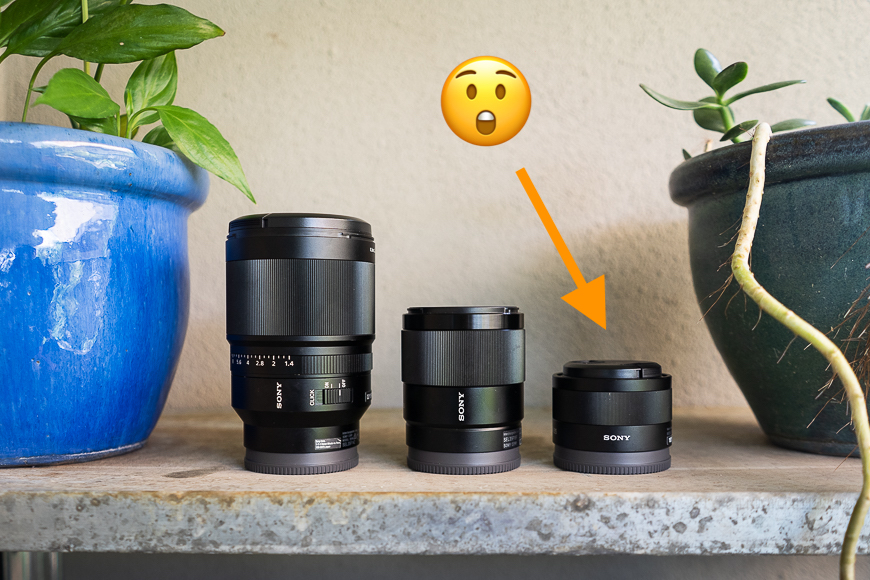
Compared to the other Sony 35mm lenses.
- Extremely compact and lightweight
- Super sharp
- Fun to use
- Pairs well with any Sony body
- Expensive for an f/2.8
One of the lightest full-frame compatible lenses made for the Sony E-mount, the Sony 35mm f/2.8 ZA may not be officially a pancake lens, but it’s so tiny and light that it literally feels like a lens cap!
Even so, the amazing manufacturers at Zeiss still managed to place high-quality optics in this little beauty. It has all the beautiful image rendering of an excellent Zeiss lens, not to mention the wonderful one-of-a-kind Zeiss color rendering.
I used this tiny Sony e mount prime lens to shoot an entire wedding in Bali a few years ago, and it didn’t miss a beat – see sample image below.

Sony a7III + Sony 35mm f/2.8 | Mark Condon
At f/2.8, it’s not particularly fast, but what it loses in speed it makes up for in its particularly small size. (A faster lens would obviously be larger and heavier.)
What’s not small on this lens, however, is the price. Still, you won’t find anything better at this size and weight out of the entire lineup of e mount lenses for Sony.
9. Sony FE 16-35mm f/2.8 GM | Best Wide Angle Zoom
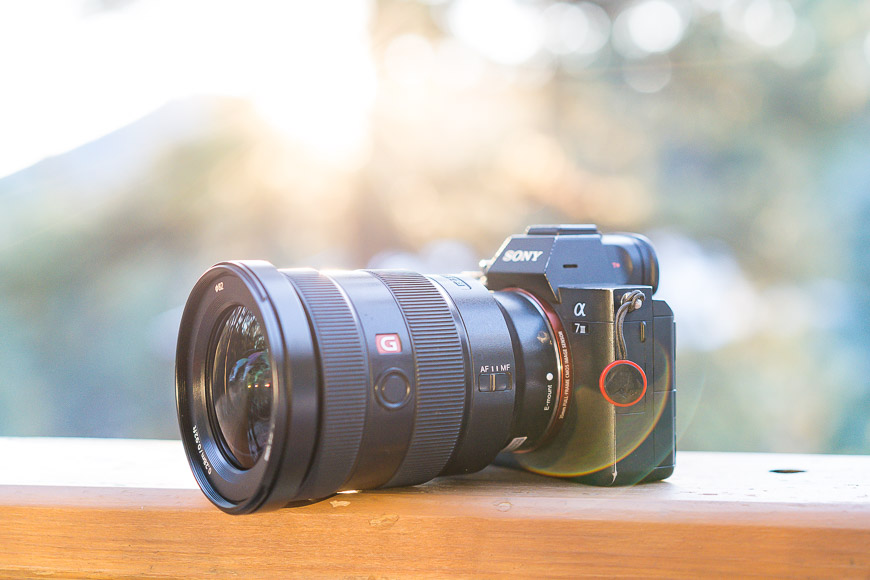
Credit: Marc Bergreen
- Constant f/2.8 aperture
- Quick auto-focus
- Decent close-up performance
- Focus-hold button
- Weather sealing
- Expensive
- Bokeh could be better
- No image stabilization
One of Sony’s flagship G Master lenses, the Sony FE 16-35mm f/2.8 GM is the wide-angle zoom of choice for professional photographers and those looking for exceptional image quality out of their landscape, cityscape, and architecture shots.
It’s our choice of the best Sony wide angle lens, since we love shooting at 35mm but also want the flexibility of getting more in the frame.
It’s not easy to build a high-performing wide-angle zoom – especially at f/2.8, but Sony managed it here. The 16-35mm f/2.8 GM delivers strong resolution wide open and is simply stunning once you bump up to f/4.
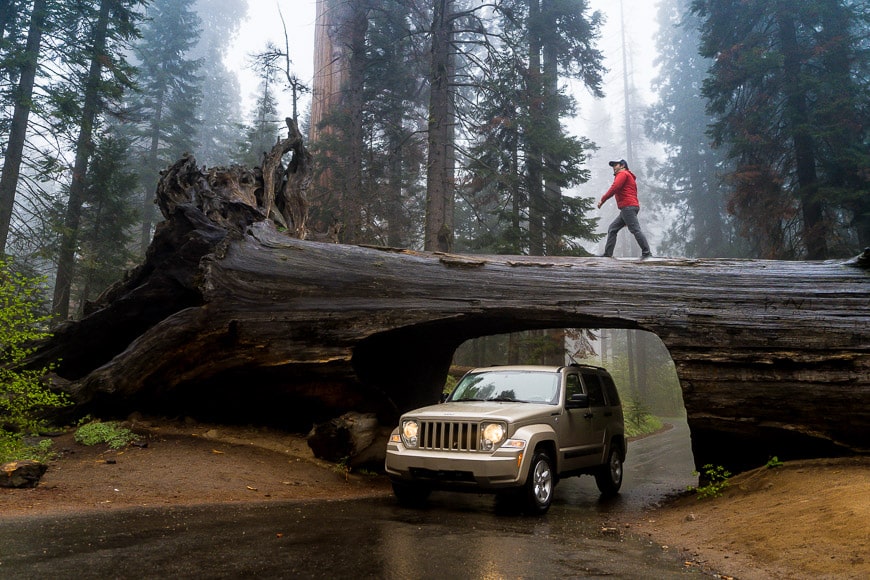
A7 III + 16-35mm f/2.8 | 1/4000 f/2.8 ISO 800 | Marc Bergreen
At just around $2,200, it’s not a cheap lens, but it’s worth the price if you’re looking for the best Sony wide-angle zoom available.
(If you can’t afford the f/2.8 GM and f/4 will work for you, take a look at the Zeiss 16-35mm F4 and/or the FE 12-24mm F4 G.)
The 16-35 is part of the ‘Holy Trinity’ of Sony lenses, with the other two being the 24-70 and 70-200 f/2.8 – if you’re fortunate enough to own all three, you can shoot virtually anything.
It’s also our choice of the best lens for the Sony a7S iii and the best lens for the Sony a7R IV mirrorless cameras.
10. Sony 50mm f/1.2 GM | Fastest (Best in Low Light)
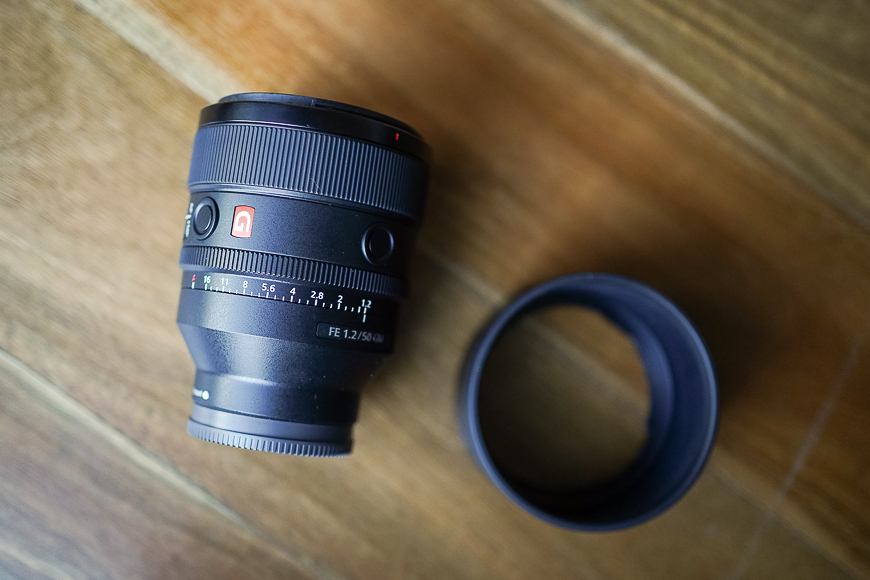
- Exceptional optics
- Incredible bokeh
- Amazing in low light
- Very sharp
- Weather sealing
- Dual function buttons
- Excellent close-up performance
- Somewhat smaller than its competitors
- Expensive
- Heavy
- Some focus breathing
Incredible in just about every aspect, the Sony FE 50mm F/1.2 GM is the nifty-fifty to get if you’re looking for literal top-of-the-line optics and performance.
There are, of course, plenty of other 50mm lenses available for the Sony FE-mount, but the F/1.2 GM stands out not only for its relatively compact size and exceptional optical performance but also for being Sony’s only f/1.2 lens.
(It’s the ‘lowest aperture’ lens Sony makes for FE mount.)

Sony a7IV + 50mm f/1.2 | Mark Condon
Smaller and lighter than both the Nikon and Canon versions, the Sony FE 50mm F/1.2 GM does pretty much everything the F/1.4 ZA can do, but just a tad better. You get a bit more aperture, a closer focus, and stellar AF performance, all in virtually the same-size package.
Should you buy it? Well, yes – if you want the best and fastest 50mm available for Sony cameras. You definitely won’t regret it.
11. Sigma 85mm f/1.4 DG DN| Best Value Fast Portrait

Credit: Jesse LaPlante
- Beautiful color rendition
- Excellent build
- Compact for an f/1.4
- Fantastic bokeh
- Weather sealing
- Half the price of its GM counterpart
- Strong pin cushion distortion
- AF sometimes struggles with fast moving objects
- Heavy vignette at times
If the Sony FE 85mm f/1.8 is too slow for you and you have a bit more to spend, take a look at this beautiful 85mm f/1.4 Art lens by Sigma.
You’ll love the images that come out of this beauty – super sharp, with great color, plenty of contrast, and immensely pleasing bokeh.

Nikon D750 + Sigma 85mm f/1.4 Art | 1/250th, f/16, ISO 100 | Jesse LaPlante
The Sigma 85mm f/1.4 Art lens also happens to be lighter, sharper, and quicker focusing than Sony’s GM version, all while costing a full $700 less. Many feel that its image quality also matches the GM, but that might be more a matter of taste.
Either way, if you’re looking for a fast portrait lens at a great price, this one should definitely be on your short list.
12. Sony FE 20mm f/1.8 G | Great for Astrophotography
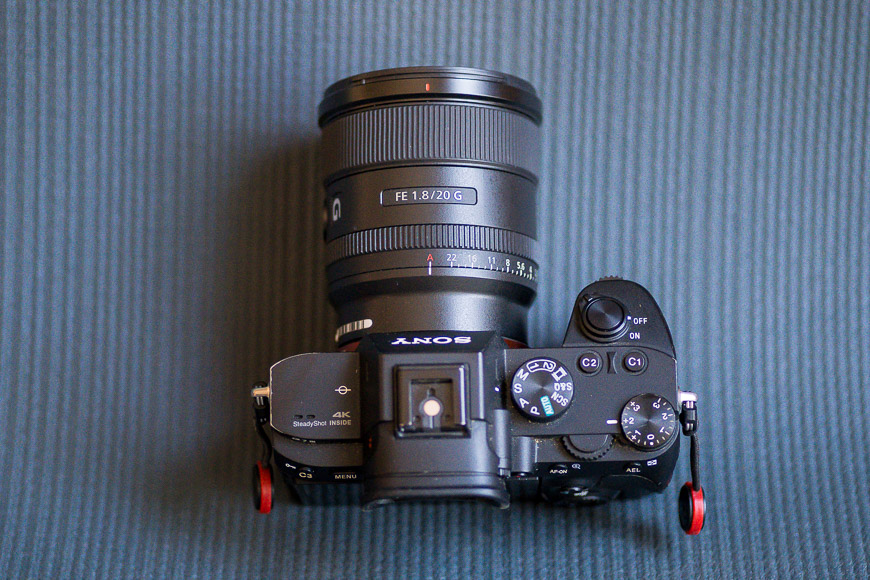
Credit: Marc Bergreen
- Amazing image quality
- Well-built and compact
- Excellent flare resistance
- Fast, quiet autofocus
- Good close-focus abilities
- Reasonably priced
- A fair amount of focus breathing
- No focus lock
The best Sony lenses for astrophotography are fast, wide, and capable of producing striking images of the night sky…a recipe that just so happens to fit the Sony FE 20mm f/1.8 G.

Sony a7III + 20mm f/1.8 | Marc Bergreen
Its fast f/1.8 aperture lets in plenty of light. The 20mm wide angle can capture long, sweeping views of both land and sky. (It’s great for landscapes too.)
The images it produces come out wonderfully sharp across the whole frame and with plenty of punch.
At just under $900 it’s not cheap, but given that it’s $500 less than the Sony 24mm F/1.4 GM and performs almost as well, the 20mm f/1.8 G is definitely a better buy.
It’s our pick of the best wide angle lens for Sony shooters who don’t see the benefit of spending much more for a marginal speed advantage.
13. Tamron FE 70-300mm f/4.5-6.3 | Great Value Long Range Zoom
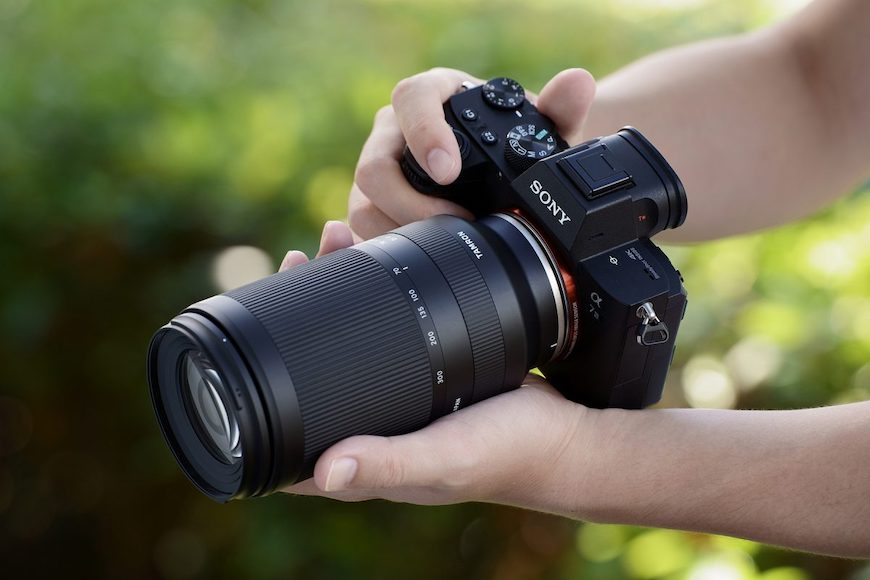
Credit: Tamron
- Good image quality throughout the zoom range
- Excellent autofocus
- Lightest and smallest 300mm zoom
- Weather sealing
- Excellent value
- Fantastic warranty
- No image stabilization
- No external switches
- Not great for close-up shots
Need a longish telephoto that still covers the portrait range? Take a look at the Tamron FE 70-300mm f/4.5-6.3.
Literally, the world’s smallest and lightest 300mm-capable full-frame mirrorless telephoto zoom, this Tamron 70-300mm retails for less than half its Sony sibling while offering good optics and excellent autofocus performance.
There isn’t any image stabilization – Tamron leaves that up to the camera – but otherwise, this is a seriously fantastic lens for its under $550 price tag.
Add to that Tamron USA’s 6-year warranty, and you’ve got a medium telephoto lens worthy of some serious consideration.
14. Sony FE 24mm f/1.4 GM | Best Wide Angle Prime
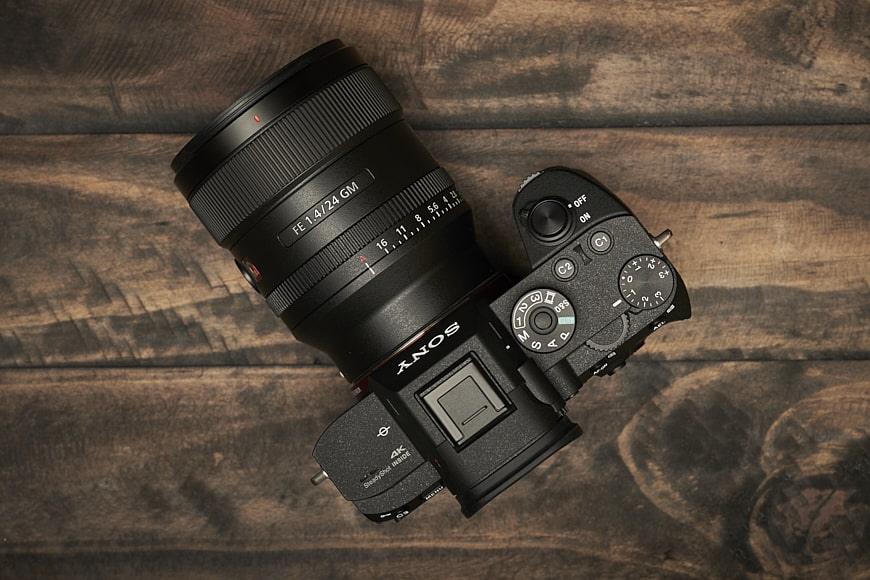
Credit: Athol Hill
- Fantastic optics
- Excellent wide open performance
- AF is fast, smooth, and quiet
- Beautiful bokeh
- Low vignette and distortion
- Nicely-damped manual focus ring
- Smooth focus pulling
- Weather-sealed
- Fairly expensive
- Some coma
- Occasional focus pulsing when backlit
If you’re in the market for an E-mount 24mm prime and want the best image quality out there, this is the one to get, hands down.
One of the best Sony prime lenses to date, the Sony FE 24mm f/1.4 GM is the perfect investment for wedding and event photographers who need a wider angle of view.
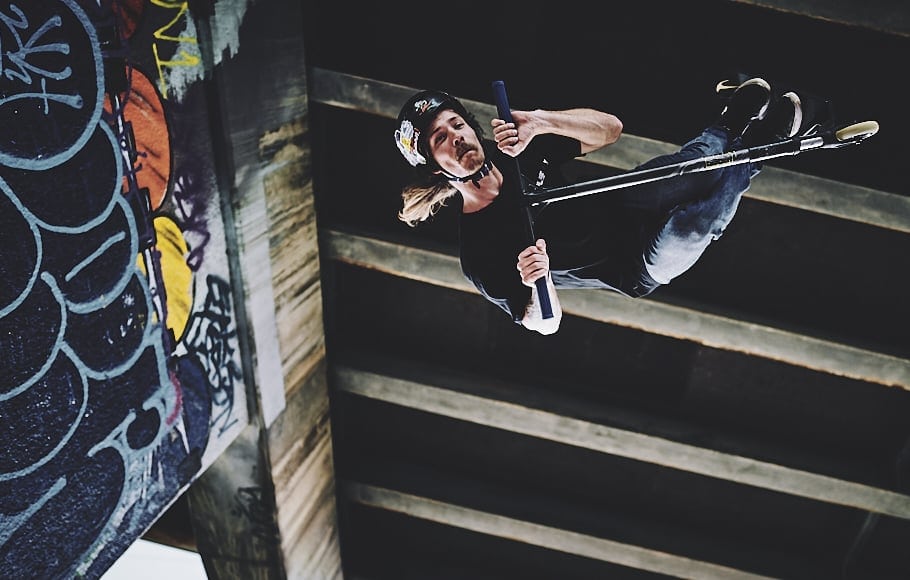
Sony A7Riii + Sony FE 24mm f/1.4 GM | 1/1000 sec | f/1.4 | ISO160 | Athol Hill
It’s super sharp on high-megapixel cameras like the a7RIII, while providing excellent optics on older models as well…all in a reasonably compact, well-built body.
The Tamron FE 24mm F/2.8 is much, much cheaper (under $350), but is a full stop slower and isn’t anywhere near the same class when it comes to performance.
15. Sony Zeiss 55mm f/1.8 Sonar T*| Sharpest Sony Lens
- Razor sharp, esp. stopped down
- Beautiful Zeiss optics
- Fast, accurate, and completely silent autofocus
- Fantastic build (includes weather sealing)
- No exterior controls
- Expensive for an f/1.8
- Busy bokeh
- Some focus breathing
The Sony Zeiss 55mm f/1.8 Sonnar T* lens is a huge favorite among many, many Sony shooters. Its excellent optics, strong autofocus performance, and compact size make it more than worth its price (which admittedly is a bit steep for an f/1.8).

Sony a7III + Zeiss 55mm f/1.8 | Mark Condon
For some, the bokeh might be a little busy. For many others, though, the uniqueness of the bokeh combined with the Zeiss color rendition creates a “secret sauce” effect.
You can, of course, find much cheaper 50mm or 55mm lenses for your Sony, but if you’re looking for one that’s top quality, the Sony Zeiss 55mm f/1.8 Sonnar T* should definitely be on your shortlist.
16. Sigma 70mm f/2.8 | Best Value Macro
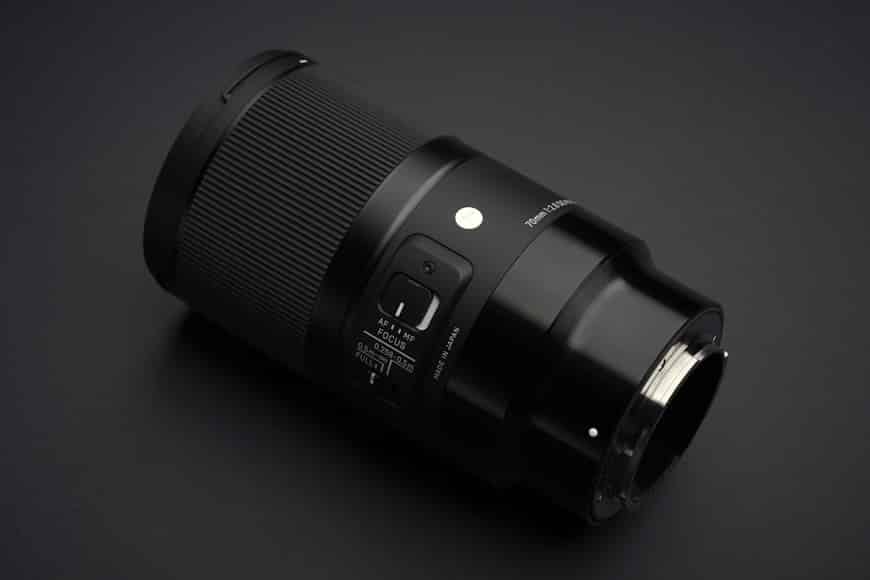
Credit: Athol Hill
- Stunning images
- Extremely sharp at all focal lengths
- Lightweight, yet solid build
- Precise focusing control
- Some weather sealing
- Great value
- No image stabilization
- External focusing
- Slow autofocus
With some of the best optics available for macro photography on Sony cameras, the Sigma FE 70mm f/2.8 Art lens marries truly exceptional optics with a fantastically reasonable price.
Sigma chose to eschew some of the “normal” conventions (i.e. external focusing, no IBIS, etc.) with this lens to focus purely on the optics…and it shows.
The images are simply fantastic.

Sony a7III + Sigma 70mm | Athol Hill
It may take a while to master focusing on this lens, but once you do, you’ll absolutely fall in love with what it can do. (The key is to understand that it was built for Macro photography, not so much as a multi-purpose lens.)
But love it or hate it, one thing that can’t be argued with is the exceptional value of this lens: you can now find it for under $500! What an absolute steal!
What are the best Sony e-mount lenses for NEX & a6000 series APS-C Cameras?
These are the top lenses that are optimized for Sony Alpha APS-C sensor cameras, also known as having a ‘crop-sensor.’ They work on both older models from the Sony NEX range, as well as anything from the a6xxx range (e.g. a6100, a6400, etc.).
Later in this guide, we’ll talk about Sony ‘FE’ lenses which have been designed for the more expensive range of full-frame Alpha cameras.
FE lenses can be attached to APS-C cameras, too – this makes sense if you plan to upgrade to a Sony full-frame camera in the future or if you already own both types and want to use the FE lenses interchangeably.
However, Sony e-mount lenses specifically designed for the APS-C sensor are cheaper and lighter, so let’s see the recommendations.
17. Sony 35mm f/1.8 OSS | Best for everyday photography
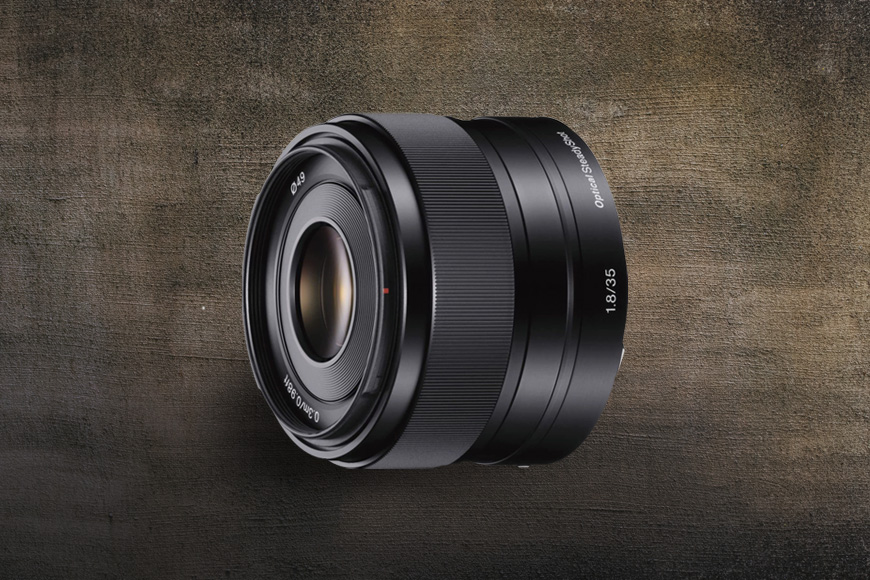
- Compact and solid build
- Good image quality
- 3-stop optical stabilization
- Fast and quiet autofocus
- Good sharpness wide open
- Minimal distortion
- No weather sealing
- Some chromatic aberration
- Can be prone to ghosting and flares
A close equivalent to the “nifty fifty” on a full-frame camera, the Sony 35mm f/1.8 OSS (sel35f18) has a focal length perfect for everything from street photography to lifestyle portraits and makes a great everyday carry.
Build-wise, it’s so tiny and light that you’ll barely notice it when attached to your camera, making it a great lens for the Sony a7c or smaller APS-C Sony cameras.
The f/1.8 aperture is perfect for capturing scenes with a shallow depth of field. Images come out sharp, nicely contrasty, and with very little distortion.
For those shooting on cameras without IBIS, the 3-stop optical stabilization will be a great aid for hand-held shooting in low-light situations.
Like most wide-angle lenses, the corners can be a little soft when the lens is wide open, but otherwise, this lens is a strong optical performer and our choice as the best everyday lens for a Sony a6000 series camera.
18. Sigma 16mm f/1.4 DC DN| Amazing Wide Angle Prime (Great for Video too)
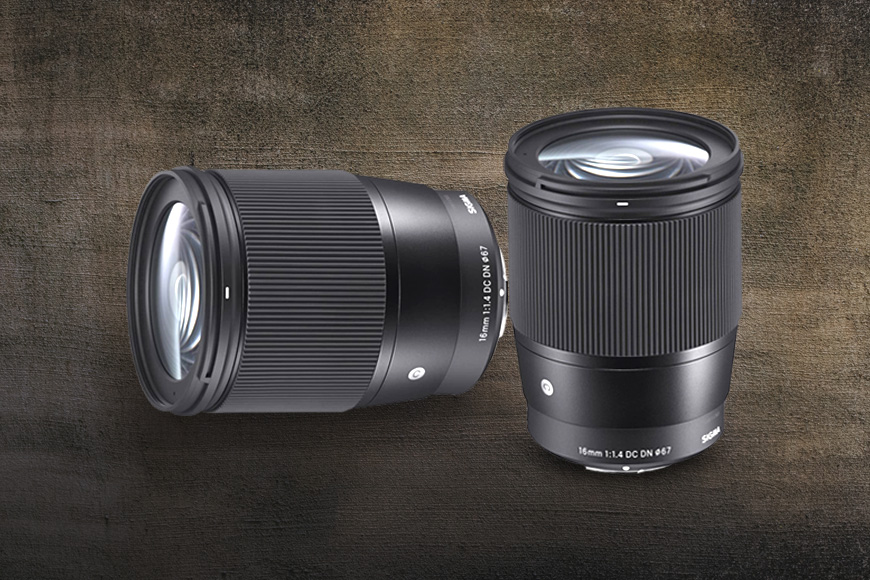
- Superb lowlight performance
- Weather sealed
- Smooth, quiet autofocus
- Compatible with all Sony AF functions
- Excellent resistance to flares
- Fantastic price
- A bit larger and heavier than other prime lenses
- Some distortion remains after correction
- Less than optimal coma performance
If you’re looking for a fast wide-angle prime that won’t break the bank, the Sigma 16mm f/1.4 DC DN Contemporary should be right down your alley.
Equivalent to a 24mm lens on a full-frame camera, 16mm on an APS-C camera is perfect for videography, selfie blogging, landscape photography, and event photography.
It’s among the best lenses for video since it offers virtually silent autofocus.
While it comes with excellent build quality and quick, accurate autofocus, the real reason to buy this lens is for its speed and superb lowlight performance. Its f/1.4 maximum aperture is just about as fast as you can buy.
Why is f/1.4 so good? When fully open, this lens will give you loads of light and a paper-thin focal plane with delicious bokeh.
At less than $400, it’s unlikely that you’ll find any other wide-angle prime matching the performance and price of this sweet little lens. Its primary competitors are almost twice the price.
19. Sigma 30mm f/1.4 DC DN | Fastest All-Rounder (Great in Low Light)
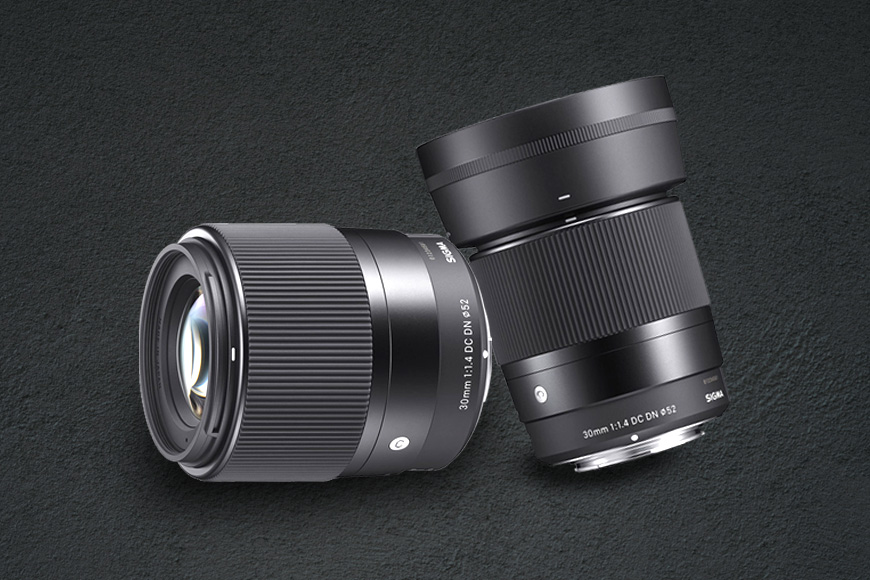
- Natural color and contrast
- Smooth bokeh
- Fast f/1.4 aperture
- Excellent close-up range
- Fast, accurate autofocus
- Well-built
- Great price
- No optical stabilization
- Chromatic aberration not well-controlled when shooting wide open
- Noisy for video recording in C-AF
The Sigma 30mm F1.4 Contemporary DC DN hits the sweet spot between price and performance, all at a focal range nearing the “nifty fifty.”
With a maximum aperture of f/1.4, this Sigma 30mm is another one of the fastest lines in this list, with plenty of light, a razor-thin focus plane, and creamy bokeh.
In fact, the focal length (45mm equivalent on a full-frame) combined with the bright f/1.4 aperture makes this an ideal everyday-carry prime lens.
The fast aperture will let you shoot both indoors and outdoors in bright or low light. The focal length is neither too wide nor too narrow. Followers of the “Middle Way” would be proud.
The sharpness of this lens is superb, especially when stopped down to f/5.6. It also works superbly with Sony’s autofocus system.
Of course, no lens at this low price point is perfect by any means, but most of its issues can be fixed in post.
Definitely a fantastic lens at a fantastic price and another great all-rounder for your a6000 series Sony camera.
20. Tamron 17-70mm f/2.8 | Best All Round Zoom
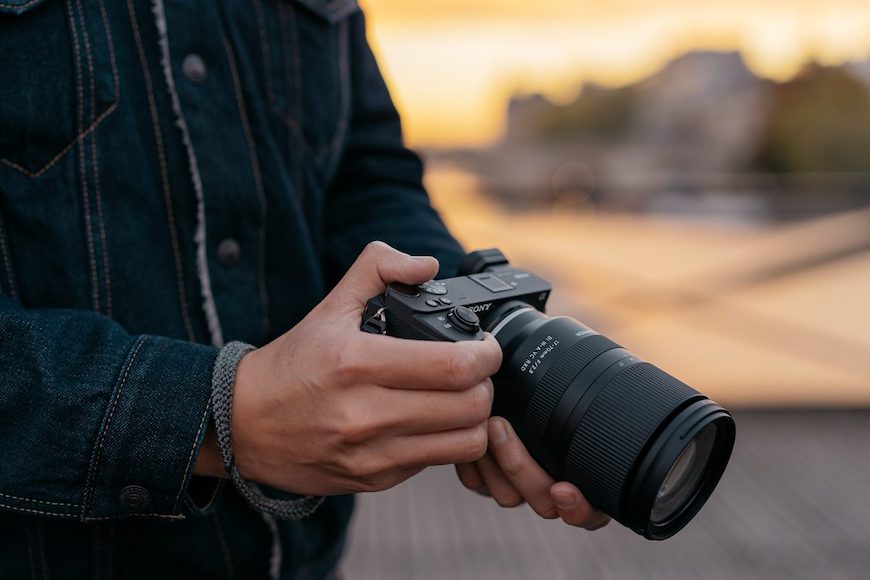
Credit: Tamron
- Extremely versatile focus range
- Fantastic optical performance
- Vibration Compensation
- AI Vibration Compensation in video mode
- Great close focus range
- Works well with Sony AF
- Weather sealing
- Great flare resistance
- No physical controls
- Onion bokeh
- Somewhat expensive
- Some chromatic aberration and distortion
- Larger than its peers
This Tamron 17-70mm f/2.8 APS-C zoom really hits the ball out of the park and is one of the best Sony APSC lenses in our guide.
Not only is it the first high-speed standard zoom designed explicitly for APS-C cameras, but its focal range is also one of the most versatile available, and the optics are the best you’ll find in this kind of zoom.
Equivalent to 25-105mm on a full-frame camera, the zoom range covers everything from wide-angle landscapes to close-in telephoto action.
The f/2.8 constant maximum aperture gathers in plenty of light and offers plenty of control over the depth of field.
Images come out highly detailed, with great color and contrast. In fact, few zooms at this price point can match the fine detail rendering (i.e., acuity) of this lens.
The Tamron 17-70mm f/2.8 also comes with vibration control, something that owners of the NEX range and older a6xxx cameras will certainly appreciate. I
The clincher? You can buy it for less than $750. What a deal!
21. Sony 18-135mm f/3.5-5.6 OSS | Sharpest Zoom
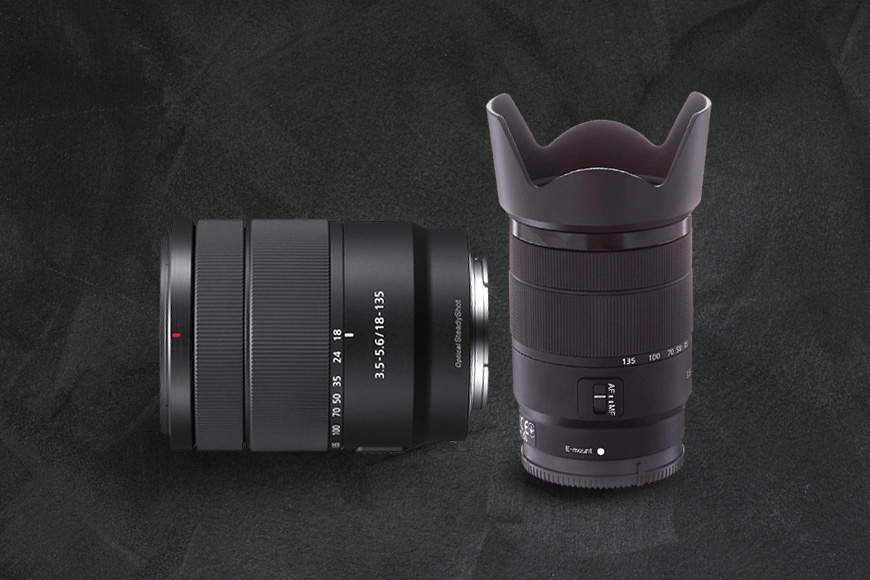
- Extensive focal length range
- Optical stabilization
- Compact and Lightweight for its zoom range
- Very sharp at all focal ranges
- AF/MF switch
- Best-priced quality zoom
- Fairly slow aperture
- Heavy vignetting in the corners when shooting in RAW
- Some purple fringing in harsh lighting
- No weather sealing
With a focal range roughly equivalent to 27-202mm on a full-frame camera, the Sony 18-135mm f/3.5-5.6 OSS is a perfect all-in-one lens for APS-C shooters who don’t do a lot of low-light photography or shots needing a shallow depth of field.
It’s not nearly as fast as the Tamron 17-70mm, but what it lacks in speed, it gains in sharpness. It’s f/3.5-5.6 is solidly sharp from the center to the edges throughout all its focal range.
Overall, the two main reasons to go with the Sony 18-135mm f/3.5-5.6 rather than the Tamron 17-70mm f/2.8 are the increased focal range and excellent sharpness throughout the zoom range.
At under $650, the Sony 18-135mm is also the least expensive Sony zoom in this category.
If, however, you need weather sealing and/or a lens that will perform better in low light, you’d be better off sticking with the Tamron 17-70mm above.
22. Tamron 11-20mm f/2.8 | Best Wide-Angle Zoom
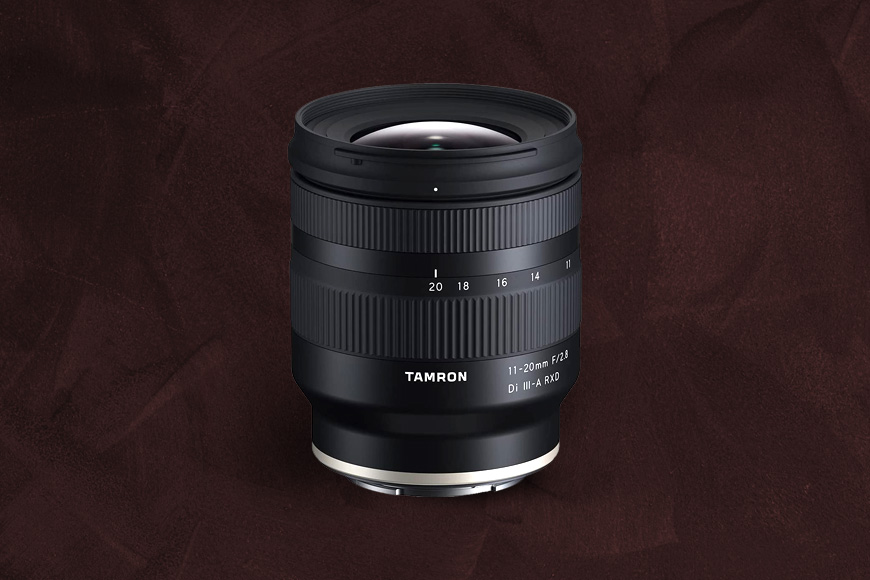
- Constant f/2.8 aperture
- Fantastic low-light performance
- Compact and lightweight
- Versatile wide-angle focal range
- Excellent close-focus range
- Fast, quiet, and accurate AF
- Fully compatible with Sony cameras
- Weather-sealed
- No external switches
- No optical stabilization
- Flare resistance could be better
There aren’t a lot of high-performing wide-angle lenses made specifically for the Sony APS-C E-mount, but luckily Tamron has stepped into the void with this excellent11-20mm f/2.8.
It’s actually the first ever compact, lightweight F2.8 ultra wide-angle zoom lens made for Sony E-mount APS-C mirrorless cameras.
Tamron’s excellent Rapid-eXtra-silent stepping Drive (RXD) works seamlessly with Sony’s native autofocus system, both with still and video shooting. When filming, focus changes from close to distant happen almost instantaneously.
The build of the Tamron 11-20mm isn’t exactly tiny but is decidedly compact for its aperture and focal range – almost unbelievably so. It’s also relatively lightweight and handles beautifully on an a6xxx body.
Even now, in 2024, there’s little competition for this zoom. The slower Sony E 10-18mm F4 OSS is priced similarly and has optical stabilization, but the Tamron 11-20mm has that brilliant f/2 constant aperture, better optical performance, and comes with weather sealing.
If you shoot landscapes, architecture, astrophotography, or travel photography, you won’t want to miss out on this lens. It’s more than worth the price.
23. Samyang 12mm f/2 | Great for Astrophotography
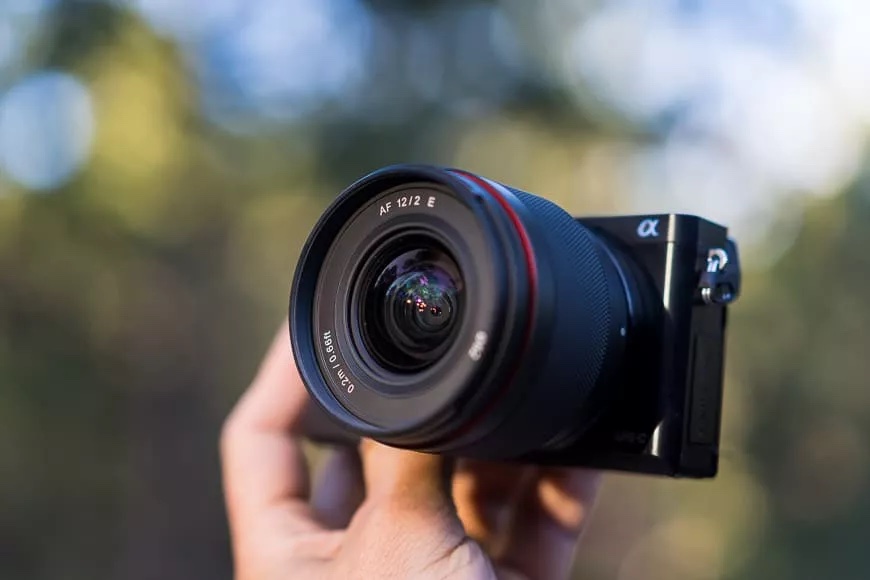
Credit Marc Bergreen
- Very sharp
- Compact and lightweight
- Fast, accurate AF
- Well-controlled distortion
- Good flare resistance
- Weather sealed
- Extremely affordable
- No external switches
- Non-reversible lens hood
- Will need to correct CA in post
- No EXIF data recorded
If you need a fast wide-angle lens and the Tamron 11-20mm f/2.8 is out of your price range, check out the Samyang 12mm f/2.
Slightly faster than the Tamron zoom and currently the widest autofocusing prime lens for Sony APS-C, the Samyang 12mm f/2 comes in at half the cost.
The focal length is equivalent to 18mm on a full frame, making for beautiful, wide-angle shots of either sky or land. Image-wise, photos come out quite sharp in the center, with pleasing colors and plenty of contrast.
Build-wise, the Samyang 12mm f/2 is nicely lightweight and compact. It also comes with weather sealing, a lens hood, and a case.
All-in-all, you’re not likely to find anything at this focal length even remotely comparable to this little lens…at least for under $400.
The combination of a fast f/2 aperture, relatively strong optics, quality autofocus, and weather sealing make this little gem a fantastic option for anyone shooting the sky, landscapes, cityscapes, or architecture.
24. Sony 10-18mm f/4 OSS | Great for Video
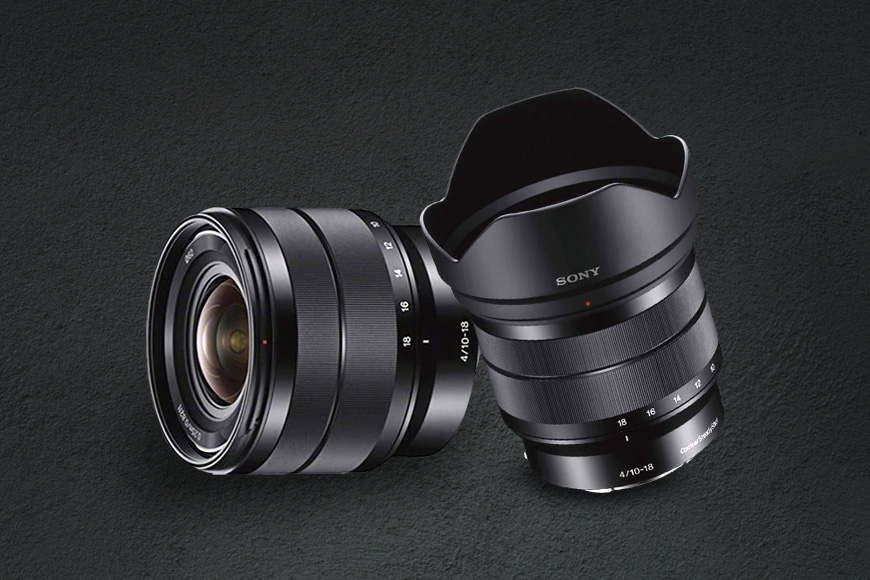
- Ultra-wide angle of view
- Good overall image quality
- Lightweight and compact
- Constant f/4 aperture
- 3-stop image stabilization
- Smooth focus and zoom
- Front filter support
- Relatively slow aperture
- No manual switches
- Expensive
- No weather sealing
One of the widest lenses you can buy for the Sony E-mount, the Sony 10-18mm f/4 OSS provides Sony APS-C shooters an ultra-wide angle field of view with optical stabilization.
At f/4, it’s not as fast as the Tamron 11-20mm f/2, but it’s a hair wider, and the OSS allows for more opportunities to shoot video without a gimbal if you’re using an older Sony APS-C camera.
The stepping motor autofocus system works quickly and accurately with both stills and video. It’s especially good for videographers needing quiet AF, and smooth video pulls.
If you also have a Sony full-frame camera, you’ll be delighted to know that this particular lens works fantastically on full-frame cameras. You’ll only get 12-18mm, but you’ll love the effect.
One of the main downsides to this lens has historically been its price, but that’s changed. You can now find it for less than $700, making it a reasonable addition to any vlogger’s kit.
25. Sony 30mm f/3.5 Macro | Best APS-C Macro Lens
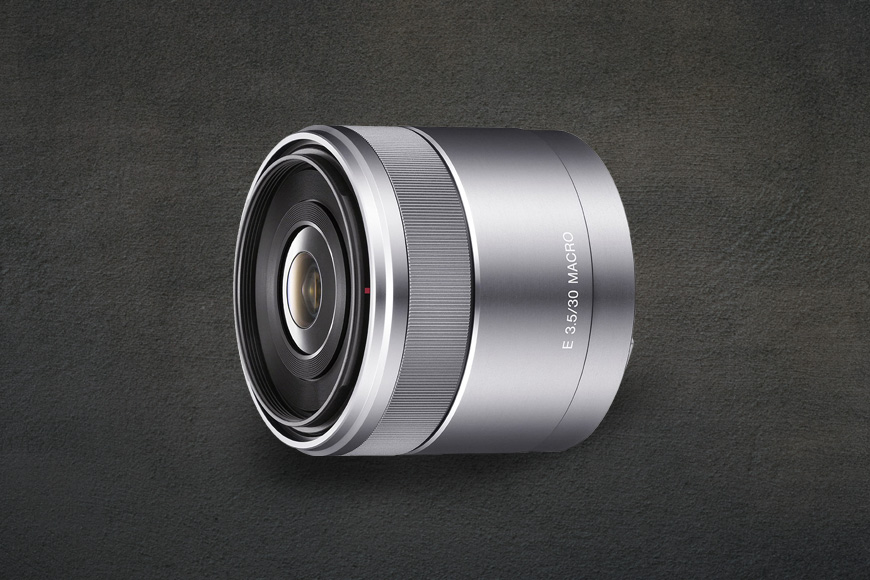
- 1:1 macro capture
- No distortion
- Light & compact
- Great value for the money
- AF sometimes hunts in low-light
- No image stabilization
- Small minimum focusing distance
Ready to graduate to a dedicated Macro lens but don’t want to break the bank? The Sony 30mm f/3.5 Macro might just be the lens for you.
The only Sony macro lens designed for APS-C cameras, the Sony 30mm f/3.5 Macro brings life-size magnification to your fingertips for under $350.
There isn’t any image stabilization, and the autofocus sometimes hunts in low light, but it’s a great learning lens if you haven’t shot Macro before.
If you’re looking for more of a bargain and are comfortable with a manual-focus-only APS-C lens, you could always opt for either the 7Artisan 60mm f/2.8 Macro MK II (under $200) or the TTArtisan 40mm f/2.8 Macro (under $100).
Otherwise, the E 30mm F3.5 is a good option for both casual Macro shooters and beginners.
(Dedicated Macro shooters should bump up to the Sigma FE 70mm F2.8 DG Macro Art or the Sony FE 50mm f/2.8 Macro.)
How do I choose a lens for a Sony e-mount camera?
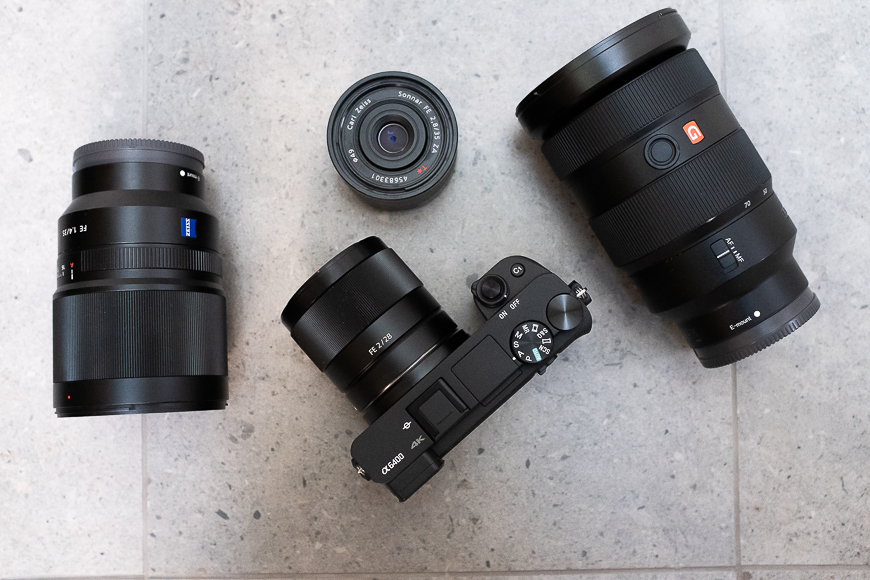
You can use FE lenses on APS-C cameras, but it’s more affordable to get e-mount lenses specifically designed for APS-C.
Lens Mounts
Sony has two main lens mount styles for its cameras: the A-mount and the E-mount. The A-mount is for its DSLRs (cameras with a mirror). The E-mount is for its mirrorless line – both APS-C and full-frame.
When looking for the right lens to buy – especially from third parties – you’ll need to make doubly sure that you’re buying an E-mount lens for your Sony mirrorless camera. (Many third-party developers like Tamron and Sigma make the same lens for a variety of different cameras.)
Beyond this, you’ll need to know whether you’re buying a lens for an APS-C sensor camera (like the a6xxx series) or for a full-frame camera (like the Sony A7 and A9 lines).
The difference between the two lies in the size of the image circle.
APS-C cameras have smaller sensors. Lenses made for them will have an image circle that only covers the size of the APS-C sensor, not more. Placed on a full-frame camera, it will come up short.
So then, what happens when you take an APS-C lens and place it on a full-frame camera?
Until recently, you’d get a pretty heavy vignette, as the crop-sensor lens doesn’t let in enough light to reach the entire full-frame sensor.
Now, however, more current Sony mirrorless cameras can detect the APS-C lens and move into “crop mode,” automatically cropping out the vignette that would normally appear in the areas the lens doesn’t cover. Alternatively, you can manually set your camera to “crop-sensor” mode.
(For older cameras, you’ll have to crop the vignette out of the photo later in post-production, i.e. while editing the image.)
In some cases, this can be really useful since it can make a shorter lens act like a telephoto lens.
Lenses made for full-frame cameras, on the other hand, have an image circle that’s larger than the APS-C sensor. As a result, full-frame (FE) lenses work just fine on an E-mount APS-C camera, though images will be considerably “zoomed in.” The camera will only show you the part of the image that the lens covers.
Summary: Sony e vs fe mount
E-mount lenses are designed for Sony’s APS-C sensor cameras like the A6000, A6400, and A6600, which have a crop factor of 1.5x. These lenses are smaller and lighter and often less expensive than FE-mount lenses.
FE-mount lenses are designed for Sony’s full-frame sensor cameras like the A7 series, the A9, and the A1. These lenses have a larger image circle to cover the full-frame sensor and are typically larger, heavier, and more expensive than E-mount lenses.
One advantage of using FE-mount lenses is that they can be used on both full-frame and APS-C sensor cameras, while E-mount lenses are not designed for full-frame sensors and cannot be used on those cameras without significant cropping.
Focal Length
The focal length of a lens determines its angle of view or how wide the image will be. A shorter focal length yields a wider image; a longer focal length allows you to zoom in on a distant subject.
Wide and ultra-wide angle lenses (14mm to 35mm on a full-frame) have a short focal length, allowing you to capture much more of a scene than a standard lens can.
Standard lenses (40mm to 70mm on a full frame) capture a scene at pretty much the same angle of view a human eye would.
Telephoto lenses (85mm to 300mm on a full-frame) have a very shallow angle of view, allowing you to zoom in closely.
Super telephoto lenses (anything beyond 300mm) are for photographing subjects that are quite far away.
One thing to keep in mind is that a lens with any given focal length will produce different results on an APS-C camera than on a full-frame camera.
For example, attaching a 50mm full-frame lens to an APS-C camera will make the lens act more like a 75mm or 80mm lens. (The focal length of the lens itself doesn’t change.) This can be super useful if you want more of a super telephoto effect but don’t want to pay for something that expensive.
Aperture
The maximum size of the aperture of a lens – or f/number – determines how “fast” a lens is. Faster lenses let in more light, allowing you more wiggle room when working handheld in darker environments. They also allow you to photograph a narrower focus plane, putting your subject in focus while blurring everything in front and/or behind it.
Faster lenses (i.e. f/1.4, f/1.8, f/2) are generally bigger and more expensive than slower lenses. They’re especially helpful if you have an APS-C camera, as the sensor is smaller and can use all the light it can get.
With zoom lenses, there’s also another thing to keep in consideration: whether the aperture is variable or constant.
A variable aperture lens automatically adjusts the minimum aperture available to your focal length. For example, on a 70-300mm F/4.5-5.6 zoom, your lens will be as fast as f/4.5 at 70mm but will decrease the farther out you go. You’ll only have f/5.6 available by the time you reach 300mm.
Variable aperture lenses tend to be lighter and more affordable than fixed aperture lenses, but you definitely get less light available at the farther end.
With a fixed or constant aperture Sony zoom lens, the aperture stays the same throughout all of the focal lengths. That means that no matter where you are in zoom, you’ll always have the same amount of light available.
For example, a 24-70mm f/2.8 zoom will have f/2.8 available at 24mm, 70mm, and everywhere in between.
Obviously, constant apertures are ideal, but they tend to be heavier, larger, and much more expensive.
3rd Party Lenses
Third-party lenses – lenses made by manufacturers other than Sony – often come with a much lower price tag than native lenses.
Sometimes this is because they are lower quality, but not always. Both Sigma and Tamron make some excellent E-mount lenses, many of which work just as well – if not better – than lenses made by Sony.
The advantage you get when using first-party lenses is that you know that the lens is fully compatible with your Sony camera. In some cases – like with GM lenses – you’re likely to be getting superior quality as well.
The advantage of third-party lenses is almost always their comparatively lower prices.
How do I attach Nikon and Canon lenses to a Sony camera?
If you want to use a Nikon or Canon lens on your Sony, never fear – in most cases, you’ll just need a lens mount adaptor.
You might not get all the features of the lens or of the camera, but depending on the lens and the adaptor, you might still get much of its original functionality.
For example, some adaptors will work great with both AF-S and AF-C. Others will just have AF-S. If you prefer to shoot manually and don’t need IBIS, you’re golden!
Why use a Nikon or Canon lens on your Sony? One reason is you might be coming from one of these systems and already have a lot of great glass you love.
Another is that there are a lot of high-quality Canon and Nikon vintage lenses available at bargain prices – you can save a lot of money.
Here are some of the more popular adaptors:
Nikon F-mount lens to Sony E-mount camera
- Monster Adapter LA-FE1
- Vello Select Nikon F Lens to Sony E-Mount Camera Auto Lens Adapter (Firmware Ver.8)
- FotodioX Mount Adapter for Nikon F-Mount Lens to Sony E-Mount Camera
Canon EF-mount lens to Sony E-mount camera
- Vello Canon EF/EF-S Lens to Sony E-Mount Camera Auto Lens Adapter
- Metabones Canon EF/EF-S Lens to Sony E Mount T Smart Adapter (Fifth Generation)
What do the letters on a Sony Lens mean?
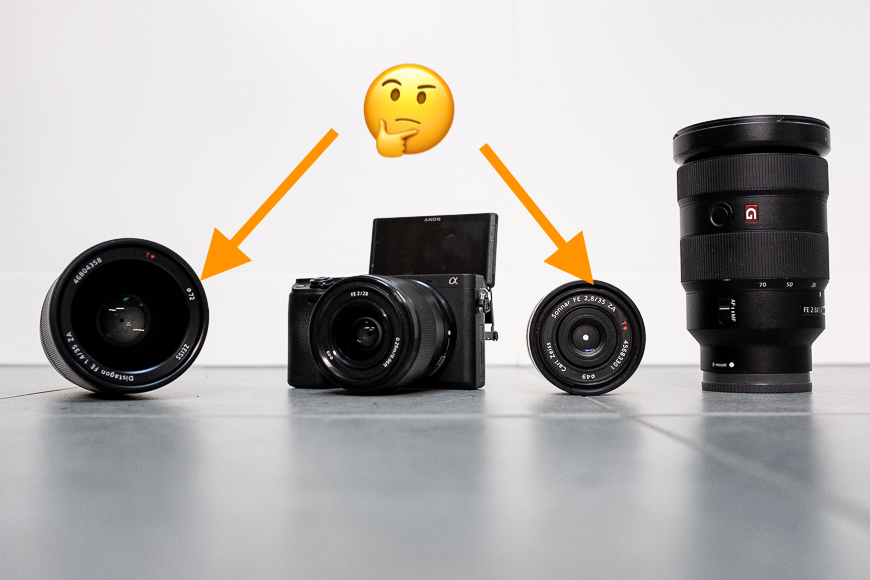
- C – Cinema lens with geared focus and aperture ring. Examples of the best cinematic lens include the Sony FE C 16-35mm T3.1 G or FE C 135mm T2.2 G which offer fast speed and useful focal lengths for filmmaking and general cinematography.
- E – E-mount lens for APS-C and Super 35 cameras.
- ECF – E-Mount Converter Fisheye.
- ECU – E-Mount Converter Ultra-wide.
- FE – Full-frame E-Mount lens.
- G – Gold Series lens. Sony’s second-highest lens tier.
- GM – Gold Master, more commonly “G-Master” lens. Sony’s highest-tier lens.
- LE – Light Edition. Only ever used once in 2012 to designate a particularly lightweight lens design.
- OSS – Optical SteadyShot is Sony’s name for in-lens image stabilization.
- PZ – Power Zoom lens with motorized zoom control.
- SEL – Only used in official product codes, standing for Sony E-Mount Lens.
- SSM – Super Sonic Motor
- T* – A lens equipped with Zeiss’ optical T coating.
- TC – Teleconverter.
- ZA – Zeiss approved “Zeiss Alpha” lenses built by Sony in Japan.
- Other Sony abbreviations you might see in the lens description include:
- AR – Anti-Reflective; the lens contains Sony’s nano-coating technology. All G and GM lenses have this.
- DDSM – Direct Drive SuperSonic Motor; Designed for moving large, heavy focus groups in some Sony lenses.
- ED – Extra-low Dispersion glass
- PZ – Power Zoom; a built-in electronic zoom motor used for controlling optical zoom on the lens.
- SSM – SuperSonic Motor; An extremely fast, quiet and accurate autofocus motor used on many Sony G and GM lenses.
- SAM – Smooth Autofocus Motor; A cheaper AF motor used primarily on a Sony’s kit lenses.
- XA – Extreme Aspherical; the lens contains Sony’s top-of-the-line aspherical element that produces extremely high resolution with beautiful out-of-focus areas. Reserved for Sony GM lenses.
What are other common questions about Sony e-mount lenses?
- What does FE mean on a Sony lens?
The Sony “FE” means that the lens is designed for full-frame Sony Alpha mirrorless cameras. Sony e lenses are ones that are designed for the e-mount.
- What does E mean on a Sony lens?
An “E” without the “F” means the lens was designed specifically for a Sony APS-C camera (i.e. the a6xxx line). It will have a smaller image circle than that of a lens designed for a full-frame sensor.
- Should I buy a new camera with a Sony kit lens?
Buying a Sony camera with a Sony kit lens included is a great way for beginners to start practicing. Kit lenses are often looked down upon by professionals, but their quality is actually much better in previous years. Kit lenses are also much cheaper than the best Sony e mount lenses mentioned in this guide.
- What is a Sony G Master lens?
GM, or Gold Master Sony camera lenses are Sony’s premium, top-of-the-line lenses. Sony G lenses are designed to fulfill all professional requirements, from exceptional image quality and performance to weatherproofing and a superior design build. They are designated on the lens with a white G on an orange square.
- What’s the difference between a Sony GM Lens and a Carl Zeiss lens?
A Sony GM lens is designed solely by Sony and uses the Sony quality standard. They focus on providing high-resolution and perfect bokeh.
A Carl Zeiss lens is a lens made by Sony using Zeiss design and technology. It uses the Zeiss quality standard, which focuses on resolution and contrast. (Sony partnered with Zeiss for two decades before making their first GM lens in 2016.)
- How do I know if my Sony lens is full frame?
A full-frame Sony camera lens will be marked with an FE on the barrel.
- What does OSS mean on a Sony lens?
OSS on a Sony lens stands for Optical Steady Shot, Sony’s in-lens image stabilization system.
- What do the names on the Zeiss lenses mean?
There are three different types of Zeiss design that Sony uses: Sonnar, Planar, and Distagon.
Sonnar – Sonnar Zeiss lenses use the Zeiss classic “Sonnar” design invented by Dr. Ludwig Bertele in the late 1920s. They feature a fast aperture, lightweight design, and fantastic contrast – all with a minimum of flare.
Planar – Designed in the late 1890s, planar lenses have a symmetrical design, with the aperture placed in the middle of the elements. This allows the lens to stay sharp from center to corner at wide apertures, all with little chromatic aberration. Almost every 50mm lens has some element of Planar design in it
Distagon – A design system Zeiss uses for its wide and ultra-wide angle, retrofocal lenses. These lenses are often heavy, as they are pretty complex. The Sony Zeiss Distagon T* FE 35mm F1.4 ZA is the only Distagon lens available for Sony E-mounts.
- How do I update the firmware on my Sony lens?
- Attach the lens to the camera. (Make sure that your camera is off before attaching/changing the lens.)
- Check the version of the camera lens system software by going to Menu →Setup → Version.
- Set the USB Connection to Mass Storage.
- Using a computer, download the update that corresponds to your lens model.
- Run the update on your computer.
- Follow the screen instructions.
- When directed, connect a USB cable to your camera, then plug it into your computer. (If your camera has both a Micro USB and USB C port, you can use either.)
- Continue following the screen instructions.
- Once the update process is complete, click the “Finish” button on your computer screen. (DO NOT DISCONNECT THE USB CABLE until your camera’s LCD screen says “Camera Update Complete.”)
- Follow the instructions on your camera’s LCD screen (which will probably include turning the camera off and then on again).
- Re-check the firmware version of the lens to make sure the update was successful. (Again, Menu →Setup → Version).
IMPORTANT: Make sure your camera’s battery is fully charged before starting the update process. If the battery dies during the firmware update, your camera may be seriously impacted.
Also, do not turn off the camera or disconnect the USB cable until the update process is entirely complete.
- What lens mount does Sony use?
Sony cameras use either an A-mount or an E/FE-mount. A-mount lenses work with Sony DSLRs. Sony’s mirrorless cameras use the E-mount and/or FE-mount.
- What’s the difference between Sony E-mount and FE?
The Sony E-mount (without the F) is a lens made for Sony APS-C mirrorless cameras.
The FE-mount signifies a lens made for Son’y full-frame mirrorless cameras.
- Can a Canon lens be used on a Sony body?
Yes, if you use an adaptor.
- How can I connect my Canon lens to my Sony body?
You can connect a Canon lens to a Sony mirrorless camera body by using a Sony E-mount adapter. For more information, see the section above.
- Can a Nikon lens be used on a Sony body?
Yes, you can connect a Nikon lens to a Sony mirrorless camera body. You just need a Sony E-mount adapter. For more information, see the section above.
- How can I connect my Nikon lens to my Sony body?
You can connect a Nikon lens to a Sony mirrorless camera body by using a Sony E-mount adaptor.
- How do I mount my Sony lens to my Canon body?
You can connect a Sony lens to a Canon camera via the use of a Canon EF-mount adaptor
- How do I mount my Sony lens to my Nikon body?
You can connect a Sony lens to a Canon camera via the use of a Nikon F-mount adaptor
Sony Lens List: Current, Upcoming & Rumors of EMount Lenses
12-24mm f/4 G
16-35mm F4 ZA OSS
16-35mm f/4 G
16-35mm f/4 PZ
16-35mm T3.1 G
16-35mm f/2.8 GM
24-70mm f/4 ZA OSS
24-70mm f/2.8 GM
24-70mm f/2.8 GM II
24-105mm f/4 G OSS
24-240mm f/3.5-6.3 OSS
28-60mm f/4-5.6
28-70mm f/3.5–5.6 OSS
28-135mm f/4 G OSS
70-200mm f/4 G OSS
70-200mm f/2.8 GM OSS
70-200mm f/2.8 GM II OSS
70-300mm f/4.5-5.6 G OSS
100-400mm f/4.5-5.6 GM OSS
200-600mm f/5.6-6.3 G OSS
20mm f/1.8 G
24mm f/2.8 G
24mm f/1.4 GM
28mm f/2
35mm f/2.8
35mm f/1.8
35mm f/1.4 ZA
35mm f/1.4 GM
40mm f/2.5 G
50mm f/2.8 Macro
50mm f/2.5 G
50mm f/1.8
50mm f/1.4 ZA
50mm f/1.2 GM
55mm f/1.8
85mm f/1.8
85mm f/1.4 GM
90mm f/2.8 G Macro
100mm f/2.8 STF GM
135mm f/1.8 GM
400mm f/2.8 GM OSS
600mm f/4 GM OSS
10-20mm f/4
16-50mm f/3.5-5.6 OSS
16-55mm f/2.8 G
16-70mm f/4 ZA OSS
18–105mm f/4 G OSS
18–110mm f/4 G OSS
18-135mm f/3.5-5.6 OSS
18–200mm f/3.5-6.3 OSS
18–200mm f/3.5–6.3 OSS LE
18–200mm f/3.5-6.3 OSS
55–210mm f/4.5-6.3 OS
70–350mm f/4.5–6.3 G OSS
15mm f/1.4
16mm F2.8
20mm f/2.8
24mm f/1.8 ZA
30mm f/3.5 Macro
35mm f/1.8 OSS
50mm f/1.8 OSS
Here are the expected lenses for 2024 and their release dates.
- Sony FE 20-70mm f/4 G Lens (Announced, Priced $1,098. Release date on March 3rd, 2023)
- Sony FE 50mm f/1.4 GM Lens
- Sony FE 300mm f/2.8 GM OSS Lens (Release date in early 2024)
- Sony FE 16-35mm f/2.8 GM II Lens
- Sony FE 24-105mm f4 G OSS II Lens
- Sony FE 28-75mm f/2.8 Lens
- Sony FE 85mm f/1.2 GM Lens
- Sony FE 100mm f/1.4 GM Lens
- Sony FE 150-400mm f/4 Lens
Best Sony E Mount Lenses | Final Words
We hope you found this enormous guide useful! It was definitely a challenge to put together, but we think it was worth it :)
Shooting with a Sony mirrorless camera is certainly a fun and rewarding experience, so it’s great that there are so many excellent own-brand and third-party lenses available for the Sony e-mount here in 2024.
If you have any questions or comments regarding any of the lenses mentioned here (or have some recommendations of your own), we’d love to hear them below.

The best Sony lens for everyday photography on a budget. Great image quality and classic focal length (Also great as an 85mm lens on APS-C).





